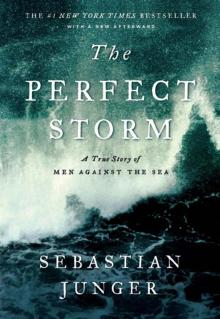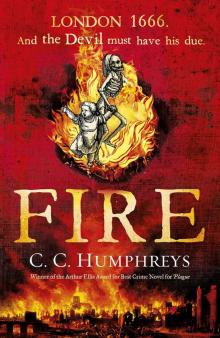- Home
- Sebastian Junger
Fire Page 3
Fire Read online
Page 3
After about an hour the helicopter was ready. It was a Bell Jet Ranger, rented from a private contractor in Arizona for two thousand dollars an hour. The huge Croman logging ships cost three times that and can sling twenty thousand pounds of retardant in a bucket beneath them. We were read the safety procedures by a helitack crewman and then asked how much we each weighed, with gear. The answers were entered into the flight manifest to calculate how much the helicopter could carry once we were out of the ground effect. Once a helicopter rises about a certain height, the downwash from its rotors no longer has the ground to push against, so it can carry less. If you combine the altitude, the air temperature, and the relative humidity, you have a figure called density altitude that determines how much a helicopter can carry. The retardant buckets, called Bambi buckets or Sims buckets, depending on their manufacturer, could even be cinched down to change the size of the container to compensate for variations in density altitude from day to day.
The crewman went over the instructions again: Keep your head down when you come and go from the helicopter. Never leave a helicopter uphill. Never go toward the rear of the helicopter. Never go anywhere that the pilot can’t see you. If you violate any of these rules, the attendant is authorized to use force to get you to comply.
“I’ll tackle you,” he said.
It was the first flight of the day for this helicopter, so the rotors weren’t turning when we boarded. Gloves on, helmets and goggles on, sleeves rolled down. The attendant made sure we had buckled our seat belts, and then he closed the doors and the rotors heaved into motion.
“By the way, why couldn’t I wear sneakers in the helicopter?” I shouted to Casey.
“Because if we crash, the nylon melts to your skin,” he yelled back.
In front of me, the copilot had a flight helmet that said, “Crashing Sucks.” The technical term for crashing is hard landing. One pilot said that half the pilots he knew had done it. Some had been killed; most hadn’t. Many helicopters these days are designed to autorotate, meaning that they don’t whistle straight downward if the engine fails. They do an awkward imitation of a glide. Most of the Boise National Forest is rocky and steeply angled, though, so it was hard to imagine its turning out well one way or the other.
The Bell Ranger lifted off, and within minutes we had put the camp behind us and I could see smoke coming off a distant ridge. It was not the furious orange blaze I had imagined; it was a 750-acre smudge fire that, if touched by wind or left unattended, could spring to life and go ripping off into the heavy timber north of here. Helicopters were shuttling back and forth from Barber Flats, where they dipped their buckets in a retardant tank. The retardant was rust-colored, and you could see it splotched on the hillsides. Below us, one of the big Cromans was easing down into a steep valley to fill its Bambi bucket in a stream. (Hotshots are fond of saying that fish get scooped up in the bucket and can be found flopping on the hillsides. No one had actually seen this happen, but the story became so widespread that the Fish and Wildlife Service hired a helicopter to see if its pilot could catch fish on purpose. They failed.) The Croman, Casey yelled, carries a bucket that is too big to fit in the retardant tank back at Barber Flats, so it has to use water. It will go back and forth all day between the stream and the fire, directed by ’shot crews with radios. The pilots are so accurate that they can hit individual trees.
We pounded in low along a ridge and then rose and banked and circled and came in again. I could see yellow-shirted hotshots below us, shrouded in smoke. The fire was down in the valley. Several crews were downslope, strung out along the creeping line of black, and several more crews had just landed at the helispot on the ridge and were waiting for orders to proceed. The helicopter made one more approach and then settled down uneasily onto a ridge that plunged steeply away on both sides. The ’shot crews crouched down against the rotor wash, and the helispot attendant, dressed in a green flight suit and hard hat and goggles, flattened himself behind a boulder as if someone were shooting at him. When the aircraft had set itself down but with the rotors still thumping, the attendant scurried forward in a crouch and opened my door and took me out by the arm. Then he returned to get Casey. Occasionally people back up into the tail rotor or walk uphill into the main one, so there is always someone at the helipad to act as an escort. I dragged my pack over behind some bushes and knelt with my head turned away. The helicopter clattered up over our heads and then continued on to shuttle more overhead around the fire.
Already the sun was hot, and it was going to be a long day of mop-up. Hotshots consider themselves elite, and a day spent cold-trailing—going through a burned area and putting out every ember—is not their idea of fun. It probably isn’t anybody’s idea of fun, but the type two crews get stuck doing it because by then the ’shot crews have usually been flown to some new emergency.
Today, however, the fire was not cooperating, as Casey said. Unless the wind picked up, everyone would be cold-trailing. The hotshots untaped the axes and shovels and Pulaskis that had been protected for the helicopter flight, and fueled up the chain saws—big Stihl 44s and 56s that the sawyers carried over their shoulders with a pad strapped to their suspenders—and took last swigs of water. It was hot on the ridgetop, but it was going to be ovenlike at the bottom of the valley, where the fire was burning and the wind couldn’t reach. Crew by crew, they reluctantly filed off downhill: the Helena Hotshots in their bright pink hard hats; the Flathead Hotshots; the Chief Mountain Hotshots from northern Montana, Blackfeet to a man. Casey motioned to me, and we started off down the slope, following a fire line that the type two crews had put in the day before.
A fire line doesn’t look like much: just a strip of ground scraped down to mineral soil that snakes around the perimeter of a wildfire. There are different kinds of fire line; the one we were on was called direct line, or hot line. It was several feet wide and cut right along the edge of the fire—“one foot in the black,” as they say. When the fire front is really flaming, the crews cut indirect line anywhere from a few feet to several hundred yards away. Often the area in between is then burned out with torches, called fusees. A burnout uses up the fuels between the line and the fire front, effectively creating a fire line up to several hundred yards wide. A burnout is different from a backfire, which is set deliberately to eliminate huge swaths of fuel in the path of an advancing fire. Often that is the only way to stop a crown fire that is throwing embers miles ahead of it; often, of course, a backfire becomes a disaster of its own. A burnout can be ordered by a crew boss; a backfire can be decided on only by the incident command team.
All handline—as distinguished from catline, which is cut by bulldozers—is made the same way. First, a line scout goes ahead of the crew and flags the route with red tape, taking advantage of anything—streams, rock outcrops, ridgelines—that won’t burn. The sawyers follow after the line scout, cutting everything from knee-high sagebrush to 150-foot trees. Each sawyer is assigned a swamper, who pulls the brush out of the way and throws it well outside the line. After the swampers come the rest of the crew, who use rakes, shovels, Pulaskis, and even their hands to scrape the duff clear and remove every shrub or root that crosses the fire line. Untouched forest or range enters at the beginning of this line, and a fuelless strip emerges out the other end. It is supposed to stop fire, and despite its appearance—narrow and insignificant in the midst of such huge geography—it generally does.
Fire line is built and measured in sixty-six-foot sections called chains, a unit of measurement that dates back to the early days of surveying. There are 80 chains to a mile, and hotshot crews should be able to cut 20 chains—a quarter of a mile—of fire line an hour. If it’s an emergency, the crew should be able to continue at that pace all day, all night by headlamp, and even all the next day. The unofficial record is sixty-seven hours, set by a California crew boss who had also gone thirty days without a shower. Technically both are in violation of agency policy.
For the time being the fire line serv
ed as a very good trail on the steep hillside, and I followed in Casey’s dust down toward the crews below us. Fifteen hundred feet farther down was the river. Casey’s job, as safety officer, was to walk around all day watching people work and talking to them about potential problems. Do they have a safety zone to retreat to if the fire blows up? Are people being posted as lookouts on each crew? Is everybody wearing a shirt? Most fires are slow-moving, and fighting them is closer to hoeing a garden than being in combat, but when fires blow up, they move with awesome fury, and if people aren’t prepared, they die.
“Seventy-two people were overrun at the Butte fire in ’85,” said Fred Fuller, part of the overhead team of one sort or another (“We’ve got layers upon layers of us out here,” he admitted). He was a lanky, soft-spoken man who was accompanying Casey and me on our rounds for a while. “They were in their fire shelters for an hour and a half. They lived, though—even the Cat operators who didn’t have fire shelters. They had to crawl under their machines. But they lived.”
Cat operators suffer some of the highest fatality rates on fires because they are reluctant to leave their machines until it’s too late; on the Butte fire they had to be dragged off their machines by other fire fighters. Burnovers are considered catastrophes even if no one gets killed, and the people who survive are given counseling within twenty-four hours. By all accounts they are terrifying experiences; that close, a fire storm is as loud as a jet plane taking off, and many of the people trapped in their shelters don’t even have radio communication. All they can do is wait and try not to let the convection winds tear the shelters off their backs.
Bob Root, a young severity crew foreman working downslope from us, put it bluntly: “If someone has to get into a fire shelter, then someone else fucked up. I mean, really.” Root has fought fire for seven years, since he was eighteen. He was a student at the Colorado State School of Forestry and also a member of the local sheriff’s search and rescue team. His severity crew, hired in advance because of severe fire conditions, was fire-ready around the clock and could be on their way within an hour. Root had straight straw-blond hair and a sunburn and dark Bollé glacier glasses. Realizing that I was as good an excuse for eating lunch as any, he sat down and pulled a brown paper bag out of his line pack.
“Probably the worst thing that’s happening now is what’s called urban interface—that is, houses in the forest,” he said. “When it’s a question of saving structures rather than just trees, we’re more likely to take risks. Basically, if you’re protecting a structure and the fire’s coming at you, you don’t retreat. You stay put and try to work the fire around either side.”
Root ate methodically, clearly in no hurry to resume cold-trailing. His bag lunch, delivered by helicopter, seemed geared toward the taste of grade school boys: bologna sandwiches, candy, cookies, more candy, and a couple of apples. As we talked, one of the Cromans came in low over us and started to ease itself down over the helispot. Dangling below it was a car-size bladder bag of water called a blivet. The pilot, looking down out of his side window, placed the blivet gingerly on the crest of the ridge and then released it from the tether. Root didn’t take his eyes off it.
“Sometimes when they punch off, the load goes downhill,” he explained. I realized that we were, in fact, directly below one and a half tons of water. He took a last look at it as he ate his sandwich.
“This is a pretty unexciting day, but last night was interesting. We were at the bottom of this slope—you never want to be above a fire—and rocks and trees were burning loose and just rolling past us. You could hear them coming. Someone would yell, ‘Rock!’ and then there’d be total silence while people tried to spot it and get out of the way. Logs would roll to the bottom and ignite the hillside, and the fire would come right back up at us. The night went by fast.”
According to Root, all over the West, fire conditions were about as dangerous as they could get. The drier the fuels, the hotter they burn and the faster the fires spread, and fuel moisture levels that should be at 15 or 20 percent are down in the single numbers. Low relative humidity and unstable air (wind) compound the problem. Fires are generally slow-moving creatures, moving a few chains an hour. But sometimes they can explode up a hillside or across a canyon, and the mountains all around us, scorched by seven years of drought, were as likely as they’d ever been to produce such behavior.
“I’ve never seen it so dry,” said Root, fingering the yellow cheatgrass around us. “One little ember in this stuff, and it ignites; last night every ember was taking. The fuels in Washington and Oregon are drier than what you’d buy at a lumber store. Now all it takes is one lightning strike in thousand-hour fuels for it to catch. That’s almost unheard of.”
Thousand-hour fuel is a piece of wood between three and eight inches thick. The thousand hours mean that if the fuel were completely saturated with water, it would take a thousand hours for it to lose 63 percent of its weight through evaporation. Conversely, if it were bone-dry, it would take a thousand hours to soak up 63 percent of its weight in moisture. Sixty-three percent is used as a benchmark because it is midway between two points—above 78 percent and below 58 percent—where moisture absorption or evaporation happens in a predictable, linear fashion. In that middle range, however, wood gains or loses moisture in a very complex way, and 63 percent is at the mathematical center point of that nonlinear range. Grass and twigs dry out or saturate almost immediately—one-hour fuels. Sagebrush and other small growth are considered ten-or hundred-hour fuels. Thousand and ten-thousand-hour fuels include everything else, up to ponderosa pine with six-foot diameters. It is very rare for thousand-hour fuels to be as dry as one-hour fuels, but they are. Everyone was worried. As one hotshot said, “There are no small fires anymore.” Everything that ignites tends to explode.
Fuel moisture levels can be established by field tests or by extrapolations based on information from the National Weather Service. The fuel moisture level is factored into an index that includes weather conditions, wind speeds, fuel loads (the total oven-dry weight, per acre, of all the fuels in the area), and drought conditions. The information is processed by the National Fire Rating System, which determines the fire risk for every climactic region in the country. It predicts such things as fire intensity, the likelihood of lightning strikes, and what is called the ignition component, the probability that a single firebrand landing in dry fuels will start a fire that requires a response. In addition, precise and highly accurate “spot” forecasts can be derived by the National Weather Service for areas as small as a quarter acre. A spot forecast may state that the temperature range for a specific canyon in the Boise National Forest will be between seventy-eight and eighty degrees; the humidity between 12 and 14 percent; and the winds ten miles an hour. Such information is crucial when ’shot crews are deployed in high-risk situations.
At the macro end of the spectrum is the general state of drought. In 1988 the whole country suffered through a brutally hot summer: Barges were running aground on the Mississippi River; railroad tracks were warping in New Jersey. The drought culminated in the fires at Yellowstone National Park. From late June until early November fires burned a total of 1.2 million acres across the West, more than half of which was in Yellowstone itself. On August 20 alone—Black Saturday—seventy-mile-per-hour winds fanned three-hundred-foot flames through a total of 165,000 acres. Although much of the country returned to normal that winter, the drought in the western states never really ended. Drought-stressed trees died by the thousands. Dry lightning storms continued to ignite huge fires. Fuel moisture contents dipped to 2 and 3 percent. The Palmer Drought Index—a water accounting system that measures water gained and lost in a given area—indicated that the entire West was entering the driest period since records had been kept in the 1870s. On the Palmer Drought Index, 0 is normal, +4 is extreme flooding, and-4 is extreme drought. During the summer of ’88 Yellowstone registered -5.8. During the Flicker Creek fire the National Weather Service declared the Boise area to
have hit -6.5.
Out here that is not an abstract figure; it has the ability to stun. I repeated it to a division superintendent on another fire, and he jerked his head back as if he’d been slapped.
Root finished his last candy bar, and we both stood up. I thanked him for the talk. Helicopters thumped continuously overhead with the Bambi buckets, and ’shot crews raised plumes of dust on the steep hillsides. Casey angled slowly uphill toward me in the high August sun, and after he arrived, we contoured across the ridge and headed for the west side, where the Chief Mountain and Flathead ’shot crews were cutting snags and putting out spots above the river. Snags (standing dead trees) are routinely cut down whether they pose a fire threat or not; some are completely hollow inside and standing on a virtual toothpick. When they let go, it is without a sound, and occasionally there is someone standing underneath. At the Red Bench fire in 1988, a hotshot was killed by a snag while waiting for a bus by the side of the road. “Death comes from above,” one hotshot warned, explaining why he walked around with his head tilted up.
We stopped to talk for a while to the Flathead crew, two of whom had been at the infamous Dude fire in Arizona when a convict crew were burned over in their shelters. Melissa Wagner, now reclined in the cheatgrass eating lunch, recalled hearing the screams of the convicts over the radio as they died. One of the survivors left his fire shelter too early and emerged from the flames with his hair smoking and 47 percent of his body burned. Six others died. Wagner kept fire fighting because she needed a way to pay for law school.
Casey and I continued toward the Chief Mountain crew, visible on a distant ridgeline with smoke coming up behind them and helicopters circling above. Halfway there, trudging through the dust and baking heat, Casey suddenly jumped back and almost knocked me down. A big rattler was coiled on a rock in the middle of the fire line. It didn’t move, and it didn’t rattle; in fact, it was headless. We reached the Blackfeet crew twenty minutes later. They were sitting in the shade of a small ponderosa, eating their lunches; way downhill, a solitary tree was torching.

 War
War The Perfect Storm: A True Story of Men Against the Sea
The Perfect Storm: A True Story of Men Against the Sea A Death in Belmont
A Death in Belmont Fire
Fire The Perfect Storm
The Perfect Storm A World Made of Blood (Kindle Single)
A World Made of Blood (Kindle Single)